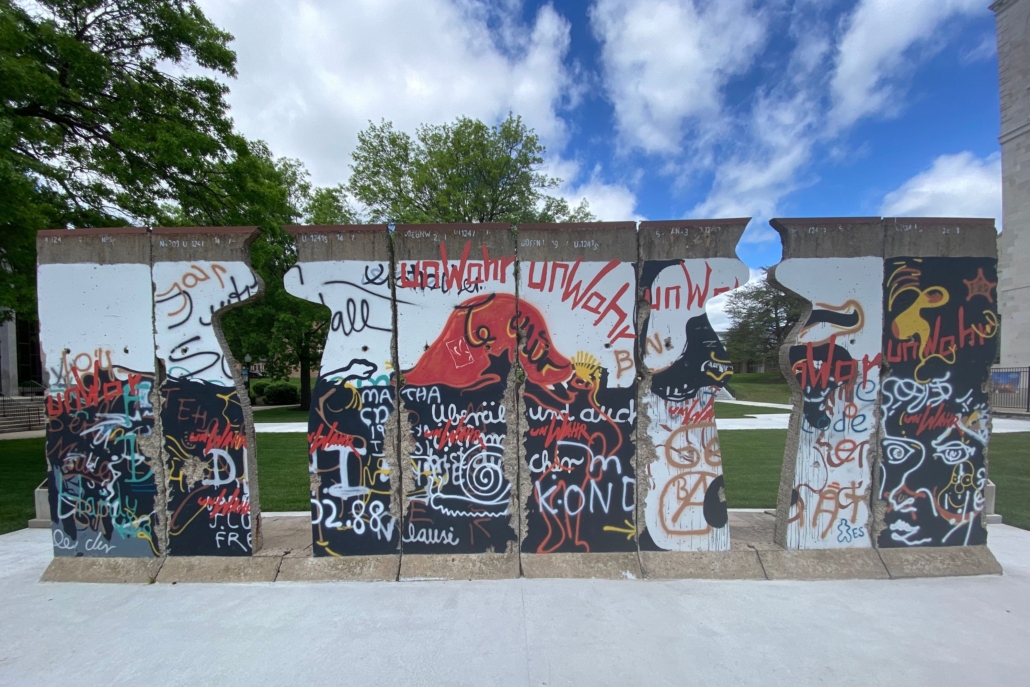A section of the Berlin Wall stood on the campus. It is the “Breakthrough” sculpture placed next to the National Churchill Museum on November 9, 1990 – one year after the fall of the Berlin Wall. I was 9 when the wall came down. I remember watching people climb the wall and hit it with a hammer on live TV. I didn’t fully understand the significance of what I was watching at the time, but later history classes would fill in the missing information. One side of the wall was a bare, stark white. The other side was covered in graffiti with “unwahr” repeated in red paint. I wrote about the wall and speculated why the graffiti was limited to one side. This was one of the first thoughtful entries I wrote in my new journal.
ABOVE: A photo of “Breakthrough” at Westminster College in Fulton, MO.
I don’t remember most of the other topics I wrote on; however, it planted a seed in fertile soil. I continued my new practice, filling notebook after notebook. I used those same Mead notebooks for a few years. They were cheap, easy to write in, and allowed for creative adornment on the cover. Eventually, I obtained notebooks specifically designed for journaling. Ones that were already decorated and made unique to keep my thoughts. I used journals with decorative covers for many years. Ones with leather-like covers, gold-paper embossed hard-backed journals with magnetic closures, and notebooks with beautiful and well-known works of art printed on the covers.
In my 30s, I started using plain brown A5 spiral notebooks made of recycled paper. I filled 3 or 4 a year, spilling my heart, mind, and soul out in ink. I decorated the barren covers with quotes, doodles, and other meaningful artwork. I bought the journals 6 at a time to ensure I had a supply on hand whenever I needed a new book. I loved how the spiral notebooks folded back on themselves, making it easy to rest the journal on my leg or the arm of a chair and write.
Around 2016, I added a new form of journaling to my practice – bullet journaling. Bullet journaling is a way to record and organize thoughts, information, tasks, and ideas into a personalized system. This system was developed by Ryder Carroll to manage his own thoughts and life. I decided to keep a bullet journal to organize my daily life, coupled with my electronic calendar. This system helps reduce my mental load, significantly reducing my day-to-day anxiety. My first bullet journals were kept in grid-lined composition notebooks. After a few years, I started using hard-back, dotted A5 notebooks created by Minimalism Art, Vivid Scribbles, and Scribbles That Matter (STM). These new notebooks had bold colors, thick, luxurious paper, and a pocket in the back. They had a more professional look and better suited my needs. I placed a single sticker on the cover of these journals – a symbol for my One Word at the time.
I filled the pages with goals, tasks, notes, habit trackers, present ideas, and all other things necessary to organize my life. I still kept a personal journal for private thoughts; however, the bullet journal became my second brain and a creative outlet. While the original bullet journal design was minimalist and simple, I used washi tape, stickers, stamps, and colorful markers to create splashier layouts. I watched other creators on YouTube to see how they set up their bullet journals, what they called a bujo. While I don’t produce stunning painted spreads like Plant Based Bride or the vibrant doodles of Amanda Rach Lee, I found my own style. I try to pick a theme each month that inspires me. Over the years, I’ve become a stationary lover, collecting Tombow markers, decorative paper, stickers, and other art supplies to use in my bullet journal, personal journal, and any other artistic endeavor I begin.
LEFT: Examples of previous and current bullet journals I use.
ABOVE: My current weekly spread allows me to plan my todos, keep quick notes, and track what I am learning.
That one simple assignment for a college class set me on a trajectory that would influence how I record my thoughts, organize my life, and process what happens to me. I sometimes wonder if that instructor knew what he was doing when we planted that simple seed more than 25 years ago. Was he just trying to get us to think about the world? Did he know he gave us a tool we could use to process and record our lives and world events? In 1984 and other literary works, journaling is an act of defiance akin to revolution. Recording your thoughts and the events around you might cause you to go against those in control. It might make it harder for them to tell you a story that fits their narrative and keeps you subservient. It may cause you to think critically as you take the time to reflect and analyze. More and more, I see my journaling practice as an act of revolution. A way to pull away from what different groups tell me life should be and what I should believe and closer to making my life what I want it to be. It helps me review my life and beliefs to find my own answers rather than blindly accepting what I am told.
Journaling is a very old practice. Marcus Aurelius kept a journal, some of which was published as The Meditations. He used his journals to plan for his day, reflect on what happened to him, and process his toughts. Anne Frank kept a journal (diary) about her life in Nazi-occupied Amsterdam and she and her family hid in a secret annex on the Prinsengracht for two years. Writers like Samuel Clemens, Ernest Hemmingway, and C.S. Lewis; scientists like Charles Darwin and Marie Curie (whose journals are still highly radioactive and kept in a lead-lined box); inventors like Leonardo Di Vinci and Thomas Edison, and artists like Frida Kahlo keep journals during their lives. Historians use journals kept during war and peacetime to understand people’s thoughts and feelings and track historical events. Julie Cameron encourages people to write morning pages (journal) daily to clear their minds and stimulate their creative flow. Journals are our pensives and unpublished autobiographies.
Journaling helps develop mindfulness, confidence, and communication skills. It allows us to process the events of our lives, including traumatic events. It can boost immunity and help us fight serious illnesses. Journaling helps people reduce their mental load and manage anxiety. Journaling is a great way to improve mental health and connect with gratitude. It can also help clarify what we want and help us maintain our focus to achieve our goals. No wonder it has been used by great thinkers and creatives for millennia.
My own journaling practice has helped me navigate high school, college, my marriage and later divorce, a major move, the deaths of family and friends, heartbreak, my career, and the ends of friendships. On the pages of my journals, I have recorded my worldwide travels and day hikes at state parks. They hold my tears and sorrows as well as my joys and gratitude. I know no matter what is going on in my life, there is space for it in my journal. I can rest there and be however I need to be in that moment without judgment or expectations.
I have a confession to make. I made one mistake in my journaling practice, one I won’t repeat. I attended a Longest Night of the Year bonfire at a friend’s house in 2009. My marriage crumbled in 2009, ending in divorce. I moved out of the home my ex-husband and I owned and into a small bungalow. I wanted to cleanse myself of my past life to make way for whatever was to come next. I chose to cleanse that night using the bonfire. I burned many things that night, including the journals I had kept since I was 16. While some people burn their journals without issue, I realize I am not one of those people. I regretted doing this many times. I wish I could go back and read some of those early journals. They record the events and thoughts of my early life. They show who I was then and help paint a picture of how I became who I am now. They also serve as an external memory when my internal hard drive fails. That night, I allowed it to all go up in smoke.
Now, I store my journals in Ikea boxes. I have no intention of cleansing myself of them again. I occasionally review my past journals. Their contents sometimes become blogs or new materials for the classes I teach. They show me who I have been and guide me to who I want to be. I always review my journals at the end of the year to say goodbye to the old year and prepare for the new. Most of the thoughts recorded on those pages will never see the light of day. These are the shitty first drafts that aren’t meant for public consumption. They allow me to process the day-to-day and work through the bitter and the hard to the better and the learning. Such a simple thing that provides me with so much.
RIGHT: Some of my past journals. I currently use A5 dot grid journals from Archer & Olive.
References
Feyoh, M. (2020). 9 Famous People Who Kept Journals. Develop Good Habits. https://www.developgoodhabits.com/famous-journals/
Phelan, H. (2018, October 25). What’s All This About Journaling? The New York Times. https://www.nytimes.com/2018/10/25/style/journaling-benefits.html
Phelan, H. (2018, October 25). What’s All This About Journaling? The New York Times. https://www.nytimes.com/2018/10/25/style/journaling-benefits.html






